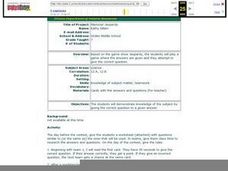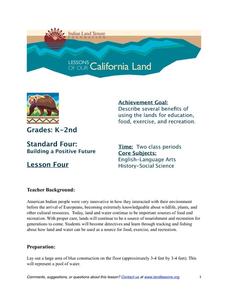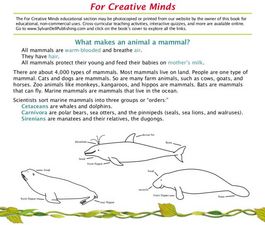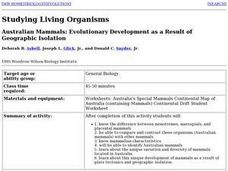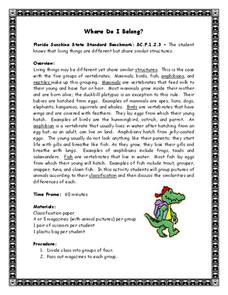Curated OER
Mammal Jeopardy
Seventh graders play a jeopardy like game using information about mammals. Before beginning the game, they complete a worksheet with questions similar to ones that are to be used during the competition. They answer more difficult...
Curated OER
Get- To Know Mammals
Students take a field trip and record information about mammals. In this mammals lesson, students hunt for tracks, waste, or other evidence that a mammal exists in this habitat. Students complete a worksheet on the evidence they have found.
Curated OER
Australian Mammals: Evolutionary Development as a Result of Geographic Isolation
Young scholars comprehend the difference between monotremes, marsupials, and placental mammals. They are able to compare and contrast these organisms (Australian mammals) with other mammals. Students are able to identify Australian...
Curated OER
Environment: Endangered Mammal Project
Young scholars research different mammals and create illustrations and narratives about them. Working individually or in small groups, students compose their rough drafts prior to creating their posters or dioramas. Young scholars...
Indian Land Tenure Foundation
Gifts from Land and Water
With a series of fun hands-on simulations, young children can learn about conservation and natural resources. Your learners become land detectives, discussing and investigating the gifts that the land and water provide them. They then...
Curated OER
Mammals
Students examine the characteristics of mammals through video clips, and slide shows. Lesson includes clips of fastest land animal, biggest mammal, loudest mammal and tallest animal.
Curated OER
For Creative Minds: What Makes an Animal a Mammal?
Young scholars read about categories of mammals and their features. Students then construct a marine animal, using given print outs in the lesson plan. Young scholars then create adaptations for their mammal, using a web site reference...
Curated OER
An Uncertain Future
Learners study the distribution of large mammals and carnivores in an ecosystem. Using maps and historical data, they examine areas for these animals such as refuges, untouched forests, prairies and grasslands. Students determine actions...
Curated OER
Classification and Adaptations- Streams, Rivers, and Lakes - Where the Land Meets the Sea And Caribbean Reef
In this science worksheet set, students answer 14 short answer questions about the classification and adaptation of life in streams, rivers, and lakes. They also answer 15 questions about life "Where the Land Meets the Sea" and in a...
Curated OER
Australian Mammals: Evolultionary Development as a Result of Geographic Isolation
Students examine the differences between monotremes, marsupials, and placental mammals and are able to contrast these organisms with other mammals. They learn about unique variation and the diversity of mammals located in Australia.
Curated OER
Mammals of Wisconsin
Young scholars explore the exciting world of mammals as they learn the identities of some Wisconsin native residents. They examine their adaptations and learn how they survive in a state with a wide array of temperatures and ecosystems.
Curated OER
What is the Evidence for Evolution?
Students identify one object that would tell the story of their lives. In groups, they determine what can and cannot be told from objects left behind. After watching a video, they compare and contrast chicken bones to human bones. To...
Curated OER
Where Do I Belong?
Fourth graders work in groups. They are given magazines. Students cut pictures of five mamals, five birds, five reptiles, five amphibians, and five fish. They place the pictures in a plastic bag. Students switch bags. They are explained...
Indian Land Tenure Foundation
Relationships to Places
Young historians take a look at how the Indian tribes of California promoted a mindful relationship between people and the land. They begin to understand how the Indians were champions of conservation, and at preserving the natural...
Curated OER
Marine & Aquatic Habitats Activities - Habitats of Birds, Fish, and Mammals on the Island and the Pacific Region
Learners create habitats in jars to understand integral aspects of plants' and animals' habitats.
Curated OER
Becoming Whales: Experiencing Discoveries of
Students experience, through a "dig," the historical discovery of fossils which increasingly link whales to earlier land-dwelling mammals. They encounter the intermediate forms which show changes that lead to the modern whale.
Curated OER
Know Your Cousins - Monotremas, Marsupials, and Placentals
Young scholars discover various mammals. In this biology lesson plan, students recognize characteristics of mammals and categorize mammal groupings. Young scholars describe how mammals grow inside the mother's body and resemble their...
Curated OER
Walking Whales
Eighth graders explore the theory of evolution of whales. In this walking whales lesson plan students study a reading packet, divide into groups and respond to given questions.
Curated OER
African Elephant
In this African elephant worksheet, young scholars discuss facts about the elephant, its lifespan, food it eats, its height and weight. Students then color a picture of the elephant. This one page color sheet contains one picture to...
Curated OER
Bats Of WI And PR
Students investigate the bats of Puerto Rico. They conduct research in order to find information to construct a powerpoint presentation. They create a dvd of the presentation and go on a tour to a local cave to see the environment where...
Curated OER
Verterbrate Classification
Students are introduced to the broad categories of vertebrates including fish, amphibians, reptiles, birds and mammals. They identify the characteristics of each group and then view slideshows and video of example species.
Curated OER
Caddo Indians Were in Arkansas First
Learners identify the relationships between the land and the lives of the Caddo Indians. They write as if they were Caddo Indians and discuss how they would feed their families based on what they have learned.
Curated OER
Studying a Piece of an Ecosystem
Students carry out an outdoor land study in which they identify organisms living in the soil, and any other animals living within the site. Groups also examine abiotic factors. They respond to a series of questions concerning their data...
Curated OER
The Chordates
Students study the characteristics of organisms that are a part of the phylum Chordata. In this organisms lesson students identify mammals that are native to Saskatchewan.


